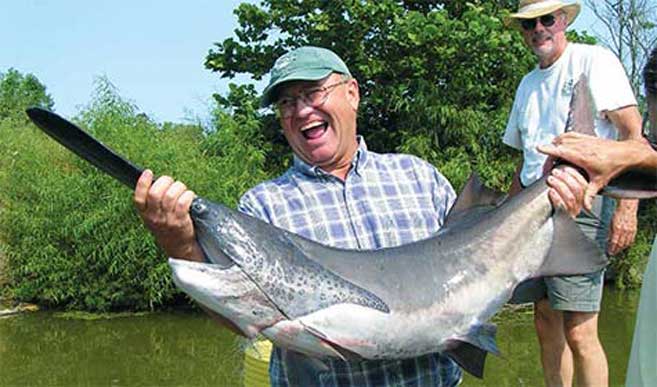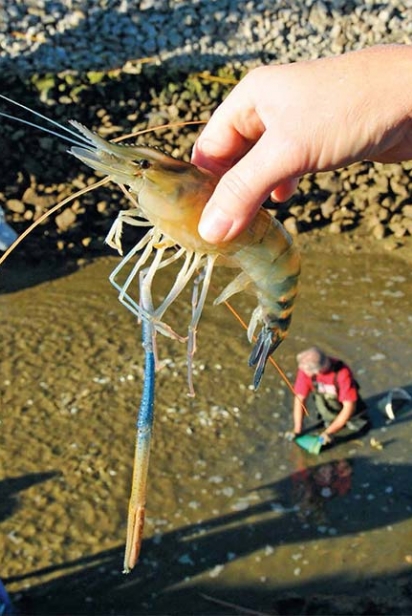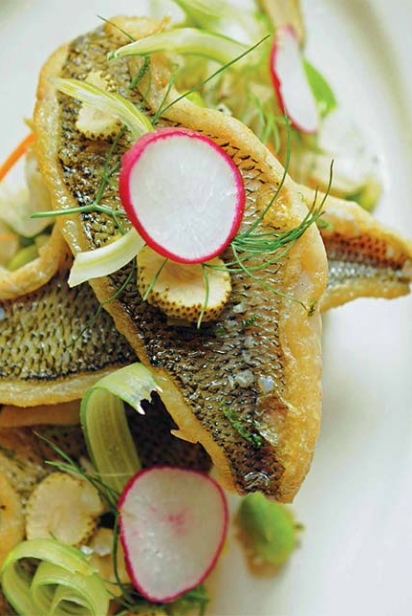Fish Tale Keeps Growing
Kentucky Seafood Hooks Expanding Markets
Kentucky farm-raised largemouth bass are red-hot sellers — in Toronto, Ontario.
Every year, 100,000 pounds of live bass are hauled 600 miles from Robert Mayer’s farm in Bardstown, Ky., to Canada. Mayer gets about $6 per pound for each 1.5-pound fish, and he doesn’t have to clean a one. No guts, no fuss, just catch and release to the Canadians.
“That supply is probably the most profitable farmed fish in Kentucky right now,” said Jim Tidwell, PhD, professor at Kentucky State University’s Aquaculture Research Center in Frankfort. “They’re going to start selling to New York soon, which could double production.”
If only the pace of farm-raised fish sales was as brisk for other species such as bluegill, paddlefish, tilapia, trout and even prawns. For nearly 30 years Kentucky farmers have attempted to diversify their operations by raising fish, but the expense of “farming what you can’t see” has represented not only a challenge to some, but a too-costly proposition.
“It’s not an easy business to start in most cases, and it’s not at all cheap,” said Tidwell, who was recruited by KSU from Alabama to lead the aquaculture program he now chairs. “But I’m confident it really could work with the right focus and commitment.”
And demand, which Tidwell said is strong when products are delivered to markets where customers can buy them. Of the several dozen Kentucky farmers who’ve tried raising fish, many of those who succeed at even producing a harvest rarely take them to broader markets. In the case of Rocky Allen, owner of Crystal Bridge Fish in Crestwood, just bringing them to the pond bank has been enough.
“I’ve never worked on taking them to restaurants because there are enough customers who see my sign out in front of my farm,” said Allen, during a recent fall harvest. “These people take care of me, so I take care of them by making sure they’ve got all the prawns they want.”
As the aquaculture coordinator and marketing specialist for the Kentucky Department of Agriculture, Angela Caporelli understands Allen’s choice to sell within sight of his home rather than move products door to door. But small-scale efforts such as Allen’s will only keep Kentucky fish off local food lovers’ radar, she said.
“There aren’t many farmers out there doing this, and that’s part of the problem,” said Caporelli, who, while working in the Peace Corps, helped establish 55 fish farms in Zaire. Before she was recruited by the State to come here in 2001, she managed the East Coast Fisheries observer program for the National Marine Fisheries Service in Woods Hole, Mass.
“Part of what I do is try and get these products in front of chefs. … But the awareness still isn’t there. If it were, we’d have higher demand for a really good and sustainable product.”
Louisville Fish Co.’s Michael Tierney wants to change that by going directly to aquaculture farms to pick up product — often live — and selling it at farmers’ markets and small retailers, such as Reynolds Grocery Co. The store, which opened last May in Louisville’s Clifton neighborhood, sources most of its produce and meats from area farms. Recently Tierney, a KSU student, took 50 pounds of live rainbow trout to The Flea off Market, a monthly outdoor bazaar in Downtown Louisville.
“It was pretty interesting being there with live fish while everyone else had old clothing and jewelry to sell,” said Tierney, whose supplier harvested the fish that morning. “I sold about 30 pounds there and then Harvest [Restaurant] bought the rest.”
Tierney also is working with Rocky Ridge Fish Farm to sell its paddlefish caviar and filets. Following a recent harvest, nearly 100 pounds of paddlefish filets were sold to Holly Hill Inn and Varanese Restaurant. Both kitchens ran out quickly, he said. “Doing this lets the farmers do what they need to do: get fish to the bank,” Tierney said. Supplied with the state’s mobile processing unit (MPU), a trailer originally designed for small-scale poultry and rabbit processing, Tierney can gut, skin and filet the fish and then package it. “From there, we can take the fish off their hands and sell it.”
SLOW PADDLING
Bluefin Seafoods, a Louisville-based distributor of seafood to restaurants, is working to add Kentucky paddlefish filets to its lineup. A year ago, Jeanine Raymond, co-owner of Rocky Ridge, brought some fresh product to Bluefin owner Ken Berry, who expressed some interest. If he could get enough product, he’d have his sales force move it. That, said Raymond, would require Rocky Ridge becoming a processor.
“We’re technically retired, so we didn’t want to do that,” said Raymond, who along with husband, Guy, produces paddlefish caviar, a difficult and labor intense effort. Their three rock quarry lakes in southern Jefferson County make up 75 surface acres of spring-fed water and are home to 2,500 paddlefish. Referring to Tierney and Caporelli, she said, “We need all these people to help process or we couldn’t do it.”
According to Jim Gerhardt, chef-owner of Limestone Restaurant in Louisville, Rocky Ridge’s caviar is some of the finest made in the U.S. When he conducted a caviar symposium several years ago, Rocky Ridge scored evenly with Osetra, the famed Caspian Sea caviar.
“We brought in caviar from Russia, North Dakota, Kentucky and Tennessee, too, and we had a panel blind taste them,” he said. “Nothing beat the Beluga, of course, but their paddlefish caviar tied Osetra and beat the others. It says a lot about its quality.” It also implies a challenging age statement: Paddlefish don’t produce eggs harvestable for caviar until they are 5 to 10 years old. And according to Gerhardt, the meat from fish that age is a bit tough.
“The age thing doesn’t synch up when it comes to caviar,” Gerhardt said. “The younger fish are much better, so we’re asking them to take the males out at about 2 years old, when the meat is more tender.”
Rocky Ridge is also diversifying some by harvesting line-caught largemouth bass and bluegill for resale. Bobby Benjamin, executive chef at La Coop in Louisville and a Rocky Ridge caviar customer, said the bass was so extraordinary that it pushed him and his cooks to create a Kentucky-ingredient- only special he ran in May.
“Kentucky bass is very versatile, has lots of flavors and loves acid,” said Benjamin. “So we sautéed it and served it with a fennel slaw with pickled jalapeños, pickled green strawberries and sautéed wood nettle. I really hope to get more of it.”
That he might not is only partly due to low supplies. Low import tariffs have allowed Asian aquaculture farmers to flood U.S. markets with government-subsidized, low-price catfish and prawns. According to Caporelli, multiple Kentucky aquaculture farms were progressing well and even a bit ahead of their plans until a glut of Asian fishes, dumped on American docks a decade ago, ran many of Bluegrass farmers out of business.
“What’s worse is those fish are not raised under the same environmental regulations ours are,” Caporelli said. When U.S. aquaculture farmers moved to raise tariffs on imported farmed fish, Caporelli said U.S. soybean producers blocked the move because it would dampen their sales to Asian markets, where soy meal is used to feed farmed fish.
“There’s been a lot of money put toward aquaculture research here, and yet foreign students come here, research it and go back overseas. That taking of intellectual property is causing competition against the U.S. and our government does nothing to help.”
LETTUCE CONSIDER THIS
Still, Caporelli remains hopeful about the industry’s future. KSU is one of the nation’s top five aquaculture research universities, and Kentucky prawns, catfish, rainbow trout, paddlefish and largemouth bass are well-managed and sustainable resources that, when exposed at farmers’ markets and on restaurant menus, always trigger demand.
Aquaculture farms also can be diversified easily, such as with aquaponics, which combines fish waste water and natural bacteria to fertilize edible plants, such as lettuces. “The aquaponics guys are going to raise the level of awareness for aquaculture,” she said. Referring to Food Chain in Lexington, she said, “It’s a sustainable closed-circuit food production system in the city limits that works!”
Tidwell is positive, too, saying that as more people become increasingly concerned about healthful foods, they’ll turn toward aquaculture fish they know is correctly raised.
“This isn’t just something the locavores want. When we take prawns to ordinary farmers’ markets here in Franklin County, the regular locals buy it,” Tidwell said.
“Farmers’ markets in Louisville call us every year asking if they can get more of it, so we know people want it.”







